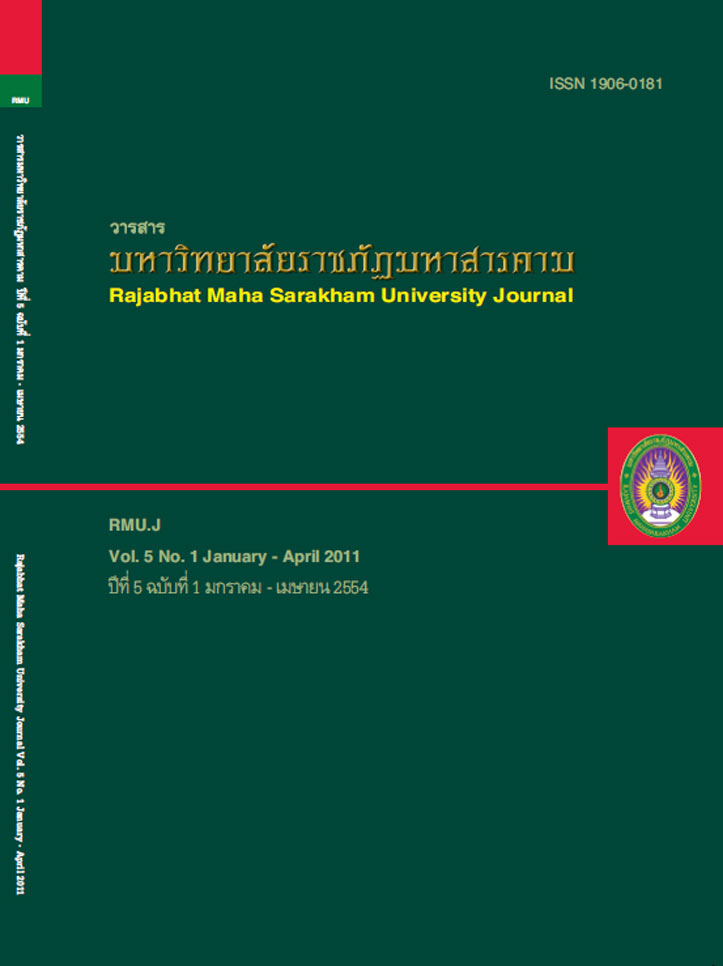การพัฒนาแหล่งเรียนรู้ในสถานศึกษาเพื่อจัดการเรียนรู้ที่เน้นผู้เรียนเป็นสำคัญ โรงเรียนบ้านหนองบัวคู อำเภอนาดูน สำนักงานเขตพื้นที่การศึกษามหาสารคาม เขต 2; Development of Learning Sources in Educational Institutions for Learner-centered Learning at Ban Nongbu
Main Article Content
บทคัดย่อ
การวิจัยครั้งนี้มีวัตถุประสงค์ ประการแรก เพื่อพัฒนาแหล่งเรียนรู้ในสถานศึกษา 2 ด้านได้แก่ ด้านวิชาการ คือ
ห้องสมุด และห้องปฏิบัติการคอมพิวเตอร์ ด้านส่งเสริมสนับสนุนวิชาการ คือ สวนป่านานาพันธุ์ สวนเกษตรพอเพียง และ
ประการที่สอง เพื่อศึกษาข้อเสนอแนะเกี่ยวกับแหล่งเรียนรู้ที่เอื้อต่อการเรียนการสอนสำหรับโรงเรียนและหน่วยงานที่ต้องการ
พัฒนาแหล่งเรียนรู้ที่เน้นผู้เรียนเป็นสำคัญ ประชากรและตัวอย่างในการวิจัย คือ ผู้ร่วมวิจัย จำนวน 15 คน ผู้ให้ข้อมูล จำนวน
50 คน ซึ่งผู้ให้ข้อมูลได้มาโดยวิธีการสุ่มแบบเจาะจง กระบวนการขั้นตอนการดำเนินการวิจัยใช้หลักการวิจัยปฏิบัติการ ตาม
แนวคิดของ Kemmis and McTaggart การดำเนินการประกอบด้วย การวางแผน การปฏิบัติการ การสังเกตการณ์ การสะท้อนผล
เครื่องมือที่ใช้ในการเก็บรวบรวมข้อมูลได้แก่ แบบสังเกต แบบบันทึกข้อมูล แบบสัมภาษณ์ แบบสอบถาม การวิเคราะห์ข้อมูล
ดำเนินการวิเคราะห์โดยแยกวิเคราะห์ คือ วิเคราะห์การดำเนินการพัฒนาด้านคุณภาพเป็นการวิเคราะห์ตามกลยุทธ์และกิจกรรม
ของกลยุทธ์ว่าได้ดำเนินการได้ตามเป้าหมายหรือไม่โดยใช้วิธีการวิเคราะห์ แบบพรรณนาวิเคราะห์ การวิเคราะห์การดำเนินการ
พัฒนาด้านปริมาณ เป็นการวิเคราะห์วัตถุประสงค์ของการพัฒนา โดยใช้สถิติพื้นฐาน ได้แก่ ร้อยละ ค่าเฉลี่ย และส่วนเบี่ยงเบน
มาตรฐาน ผลการวิจัยพบว่า
การพัฒนาการดำเนินงานเพื่อพัฒนาแหล่งเรียนรู้ในสถานศึกษาเพื่อจัดการเรียนรู้ที่เน้นผู้เรียนเป็นสำคัญ โรงเรียน
บ้านหนองบัวคู อำเภอนาดูน สำนักงานเขตพื้นที่การศึกษามหาสารคาม เขต 2 ผู้วิจัย และผู้ร่วมวิจัยมีความรู้ความสามารถดำเนิน
การตามแผนดำเนินการพัฒนา เกิดแหล่งเรียนรู้ที่เอื้อต่อการเรียนการสอนเพิ่มขึ้น 4 ฐาน คือ ฐานห้องสมุด ฐานห้องปฏิบัติการ
คอมพิวเตอร์ ฐานสวนป่านานาพันธุ์ และฐานสวนเกษตรพอเพียง และมีบรรยากาศการเรียนรู้ดีขึ้นเป็นที่ชื่นชมของผู้มาเยี่ยมชม
ครู นักเรียนได้ใช้ประโยชน์จากแหล่งเรียนรู้อย่างคุ้มค่า รู้จักแสวงหาความรู้ด้วยตนเองตามความสนใจ จากการพัฒนาแหล่งเรียนรู้
ในสถานศึกษาเพื่อจัดการเรียนรู้ที่เน้นผู้เรียนเป็นสำคัญ กลุ่มตัวอย่างมีระดับความคิดเห็นต่อสภาพและการพัฒนาแหล่งเรียนรู้ในสถานศึกษาโดยรวมอยู่ในระดับมาก มีค่าเฉลี่ย 4.16 ระดับความพึงพอใจต่อการพัฒนาและการใช้แหล่งเรียนรู้ของนักเรียนชั้น
ประถมศึกษาปีที่ 1-6 โดยรวมอยู่ในระดับมากที่สุด มีค่าเฉลี่ย 4.56
This research aimed at studying twofold: 1) to develop learning sources in the educational
institution in two aspects: the academic aspect comprising the library and the computer laboratory; and
the academic support aspect comprising the forest garden, the sufficiency agriculture garden; and 2) to
study recommendations on learning sources which help instruction in schools or organisations that
require learner-centered learning sources development. The population consisted of 15 co-researchers.
The samples were 50 key informants selected by the purposive sampling technique. The research
procedures were on the basis of action research principles designed by Kemmis and McTaggart. The
four steps for conducting research were planning, operation, observation, and reflection. The
instruments used for data collection were an observation form, a record of data, an interview form, and
a questionnaire. The data were separately analysed. Firstly, the qualitative development performance
was analysed to check whether or not the strategies and activities of the strategies served the purposes
of development, and descriptive analysis was employed for qualitative data interpretation. Secondly, the
quantitative development performance was analysed for the purposes of development. Percentage,
mean, and standard deviation were employed for quantitative data interpretation.
The results of the research revealed as follows:
The researcher and the co-researchers gained knowledge and ability to perform learning
sources development as planned in educational institutions for learner-centered learning at Ban
Nongbuakhoo School, Nadoon District, under Maha Sarakham Educational Service Area Office 2. Four
learning sources were found to promote learning: the library, the computer laboratory, the forest garden,
and the sufficiency agriculture garden. Learning atmosphere became better and was appreciated by
visitors. Teachers and students made use of these learning sources worthily. They learned how to gain
knowledge by themselves from the developed learning sources in educational institutions so as to serve
their particular interest. The sample’s opinion on learning sources development in educational
institutions for learner-centered learning, as a whole, was at a high level. Grades 1-6 students’
satisfaction towards the development and the use of learning sources, as a whole, was at the highest
level.
Article Details
1. บทความที่ลงตีพิมพ์ทุกเรื่องได้รับการตรวจทางวิชาการโดยผู้ประเมินอิสระ ผู้ทรงคุณวุฒิ (Peer Review) สาขาที่เกี่ยวข้อง อย่างน้อย 3 ท่าน ในรูปแบบ Double blind review
2. ข้อคิดเห็นใด ๆ ของบทความที่ลงตีพิมพ์ในวารสารมหาวิทยาลัยราชภัฏมหาสารคาม นี้เป็นของผู้เขียน คณะผู้จัดทำวารสารไม่จำเป็นต้องเห็นด้วย
3. กองบรรณาธิการวารสารมหาวิทยาลัยราชภัฏมหาสารคาม ไม่สงวนสิทธิ์การคัดลอกแต่ให้อ้างอิงแสดงที่มา


